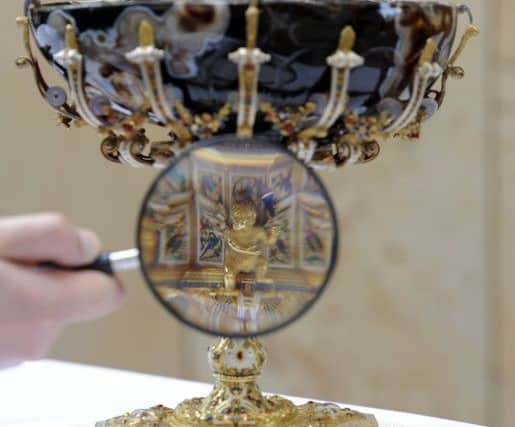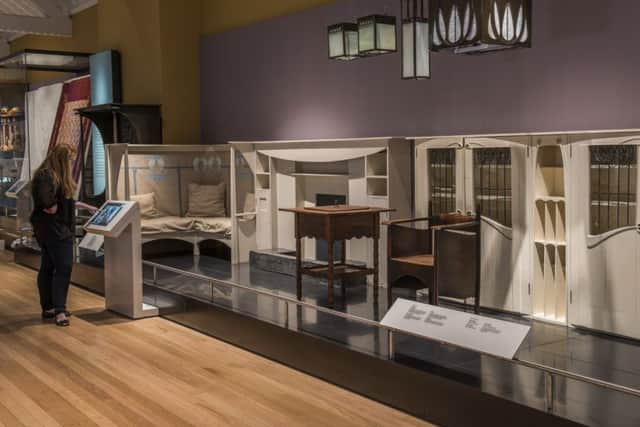Everyday masterpieces at the National Museum of Scotland


It’s the toast rack which grabs my attention. Alright, it’s silver-gilt, part of a tea service made for Napoleon on the occasion of his marriage to the Arch Duchess Marie-Louise of Austria in 1810, and it comes accompanied by a glittering punch bowl and a sugar bowl adorned with the emblem of the imperial eagle, but it is still recognisably a toast rack; a familiar object in the midst of so much splendour.
Napoleon’s tea service – half is here, the other half in the Louvre – is just one of the items on display in the National Museum of Scotland’s new Art of Living gallery, which showcases some of the finest objects in the Museum’s collection, dated from around 1200 to 1850. These are the most luxurious things, made by the finest craftsmen for the richest clients, objects intended to express power, or religious devotion, or just ostentatious wealth.
Advertisement
Hide AdAdvertisement
Hide AdLight sparkling off gold and glassware, case after case revealing sumptuous fabrics and exquisite craftsmanship – perhaps this is the story we expect museums to tell. But in the three new galleries at NMS devoted to Decorative Arts and Design, this is only the beginning. Revealing new acquisitions, and many objects which have been in storage for decades, the galleries not only tell the story of the past through luxurious objects, but explain how design became democratised, no longer just the preserve of the rich but an important part of everyday life.


The Design for Living gallery takes up the story in 1851, the year of the Great Exhibition. The event was a triumph, expressing Britain’s achievements in empire and industry, but the country’s success in the design competitions is better glossed over. “It was a huge financial success, one of the most wonderful events of the 19th century, but Britain didn’t do terribly well in the design prizes,” says Sally-Anne Huxtable, principal curator of Modern and Contemporary Design at NMS. “The Great Exhibition became an impetus to reform design.”
Over the next 100 years, Britain as a nation gradually woke up to the possibilities of design. In 1851, this was only beginning, but decorative objects, many of them poorly designed copies of French motifs, were being snapped up eagerly by home-owners. “Industrialisation changed things,” says Huxtable. “It wasn’t just the aristocracy any more, there are people who work in trade, managers and clerks, the whole machinery of capitalsim is coming into play, people are wanting to express themselves through objects. This is the beginning of the modern world.”
In the 1850s, Government initiatives to improve design, which had begun two decades before, were beginning to bear fruit. In 1856, Owen Jones from the Government School of Design published the hugely influential book, The Grammar of Ornament, a resource book for designers drawing on traditions from all over the world. One of his pupils was Glasgow-born Christopher Dresser, still regarded as one of the most important designers of his age. A display case devoted to Dresser reveals both the range of objects he worked on and the variety of influences he drew upon.
Huxtable says: “Dresser uses all kinds of global design influences, Persian, Chinese, Japanese, Aztec, African. He was one of the first designers to go to Japan when the country began to open up. He is the first industrial designer for me, because he never produces his own designs, he works with big companies, he’s very modern in that way. He would make sure an object looked beautiful and would test it to make sure it really worked. Form and function went together.”


At the same time as Dresser was beginning his career, William Morris was in Oxford, keeping company with the Pre-Raphaelites, and sowing the seeds of the Arts & Crafts Movement. The movement looked back to an idealised medieval age, and forward, through radical politics, to a world revolutionised by good design for all. But hand-made craftsmanship did not come cheap. Morris, for all his ideals, tended to make his living through working on the houses of the rich.
At the same time, even those who couldn’t afford an Arts & Crafts house were buying into the aesthetic. “The 19th century was the first time you got mass advice to the middle-class about decorating your interior,” says Huxtable. “There were magazines and books dedicated to the artistic interior, it was very much part of that democratisation of design. If you can’t afford a Morris interior, here’s what you can do, take ideas, choose the colours, have a cheap version of the wallpaper or textiles. It is the beginning of modern consumerism, the idea that what you own expresses your identity, it’s no longer the preserve of the aristocracy.”
Advertisement
Hide AdAdvertisement
Hide AdBy the end of the 19th century, an unknown Scot was making waves in the world of design. Charles Rennie Mackintosh and his wife Margaret Macdonald are represented here by an important collection of furniture and objects. When they exhibited at the Vienna Secession Exhibition of 1900, their work influenced developing trends in Austria and Germany. “Britain is now the crux of design reference in Western culture,” says Huxtable. “Certain developments in Austria wouldn’t have happened if they hadn’t seen the work of the Mackintoshes, particularly Margaret. There was an incredible movement of ideas in design. Everything was being shared, you could find anything – it was like the internet now, just a bit slower.”
In Europe, the roots of what we now recognise as Modernism were beginning at Bauhaus, the influential design school in Germany founded by architect Walter Gropius. The Design for Living gallery boasts a dressing table designed by Marcel Breuer for the master’s house at the second Bauhaus in Dessau.


Although the style looked very different, the ethos of the movement had much in common with William Morris. “The ideas of Bauhaus were not that different from the Arts & Crafts movement,” says Huxtable. “Great materials, great design for everyday life and great materials. These things are not affordable, at this point, for every day, but these are the things which filtered down and became more affordable, because pared down design is easier to mass-produce than elaborate hand-crafted objects. And even if you couldn’t afford a Mies van der Rohe house, you could perhaps afford a Gropius teapot.”
In Britain, it took the pressures of the Second World War to usher in for good the practicalities of affordable design. Manufacturing of goods not essential to the war effort was rationed, and furniture and clothing needed to carry the Government controlled CC41 stamp. The best designers were recruited by the Government to create the examples on show here. “Materials were rationed, everything needed to be functional, but they were actually really well designed,” says Huxtable. “It brought British design on in leaps and bounds really because, rather than thinking about things being frou frou or ornamental, there was an emphasis on function. It really precipitated that British modernism you see in the Festival of Britain.”
The third gallery, Making & Creating, brings the story up to the present day. Affordable design gathers momentum, with well known figures from the art world designing objects for mass production. Picasso created a series of ceramics for the Madoura workshops in Vallauris, which were then editionalised. Eduardo Paolozzi designed a series of plates for Wedgewood in the 1970s. For the first time, people could afford works by famous artists – even if these are now highly sought after collector’s items. Companies such as Alessi expanded, bringing contemporary design to a mass market, and Scandinavian modernism gave birth to Ikea.
But bling didn’t go away. Post-war studio movements brought another return to artist-produced objects for more exclusive markets. There are studio success stories, like Glasgow-based Timrous Beasties, represented here with their “Bloody Empire” wallpaper, and Scottish designer Michael Eden, commissioned to make a new work for Making & Creating using 3-D printing. NMS’s important collection of contemporary jewellery reveals designers pushing forward the limits of what they do – Terhi Tolvanen working with cement, or Nel Linseen with paper. The future of design is as hard to predict as ever – which is exactly as it should be.


COLLECTED TREASURES
The Hamilton-Rothschild Tazza
A Byzantine sardonyx bowl believed to have belonged to the Emperor Charlemagne, acquired by the 10th Duke of Hamilton while he was serving as British ambassador to Russia in 1878, placed on a 16th century gold base which belonged to Philip II of Spain. Its special provenance made this the most highly valued object in the Dukes of Hamilton’s collection. It was acquired by NMS in 2012.
Grand Piano, Phoebe Traquair and Robert Lorimer, 1909-10
Advertisement
Hide AdAdvertisement
Hide AdThe piano forms the centrepiece of an important collection of objects by Phoebe Anna Traquair which also includes jewellery, book binding and embroidery, and showcases her particular take on the Arts & Crafts movement. Traquair painted this case, designed by Lorimer, with scenes connected to music and love inspired by the Song of Solomon, Dante Gabriel Rosetti’s poem “Willowwood” and the figure of the god Pan.
“Summer” gesso panel, Margaret Macdonald Mackintosh, 1904
This beautiful panel depicting a woman and four infants is based on a 1897 watercolour, one of four inspired by the seasons, by Mackintosh and her sister Frances. It is believed to have been displayed in the drawing room in Dunglass Castle, for which Mackintosh and her husband created furniture and decoration. It is part of an important collection of Mackintosh objects at NMS, displayed together here for the first time.
Necklace, Georges Braque, 1965
This rare piece of jewellery designed by the famous cubist painter is inspired by the myth of Peleas and Nele. Braque produced some 113 designs for jewellery which were exhibited, to great acclaim, at the Louvre in Paris in 1963. The only other known example of this work is in the Metropolitan Museum of Art in New York.
“Campionissimo” Milled Aluminium Bowl, Drummond Masterton, 2008
Italian cyclist Fausto Coppi won the Giro d’Italia and the Tour de France in the same year in 1952, and became known as “Il Campionissimo”. This bowl, which commemorates that event more than 60 years later, is decorated with the route’s profile, and evokes the Alps through texturing and cutting. Created by a young Scottish designer originally trained at Gray’s School of Art, Aberdeen, it represents a triumph in this field of craftsmanship. n